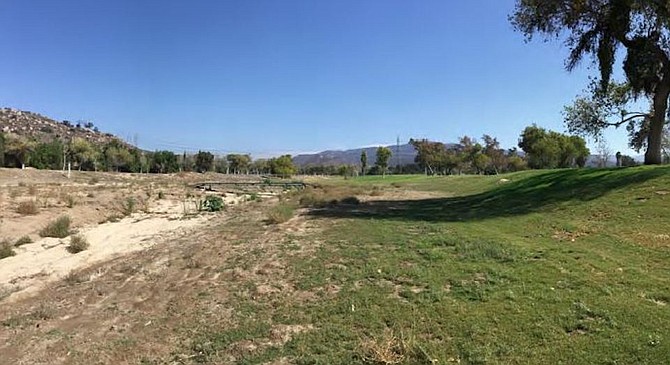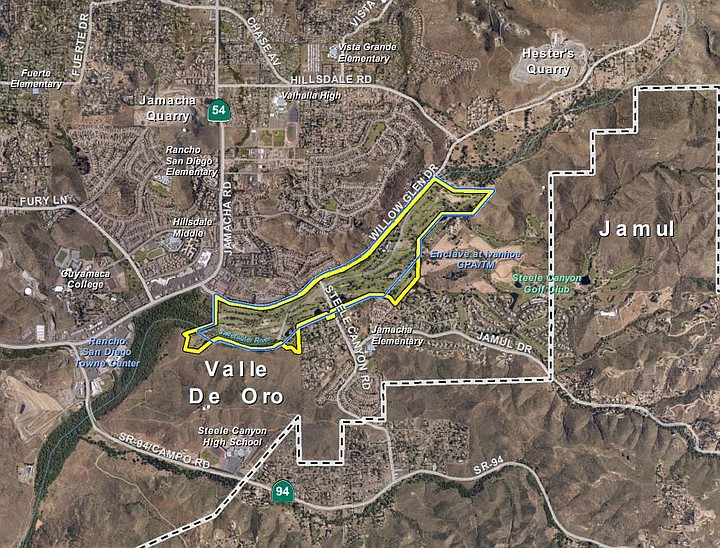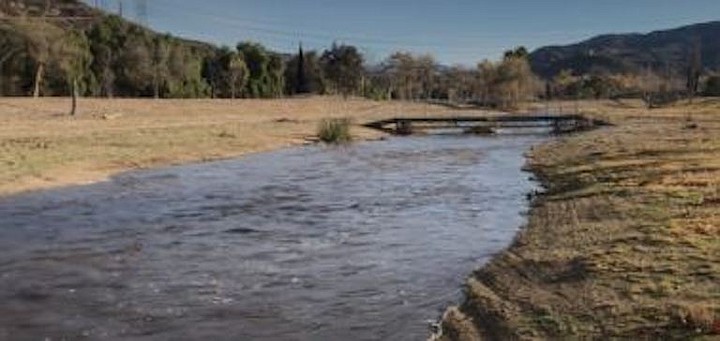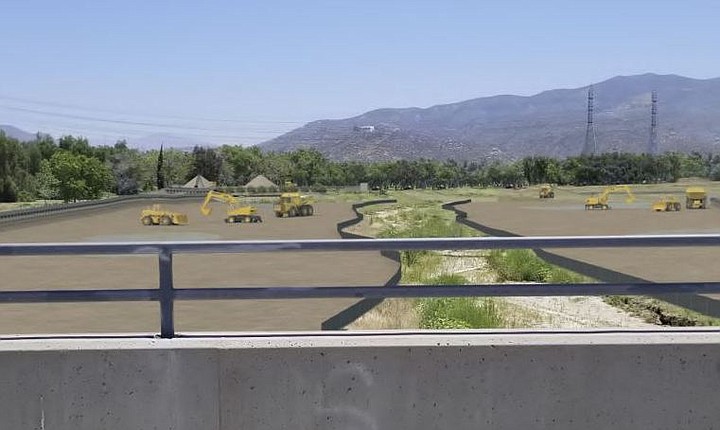 Facebook
Facebook
 X
X
 Instagram
Instagram
 TikTok
TikTok
 Youtube
Youtube

A long-awaited environmental impact report for a sand mine along the Sweetwater River in El Cajon is up for public review.
While developers say a local supply of sand will benefit the environment, opponents are looking for every last hole in the draft report's findings, which tout "less than significant" impacts once mitigation efforts are in place.

Without such measures – silt fences to control erosion, for example, there would be significant effects on aesthetics, noise, biological, cultural, paleontological, and tribal cultural resources, the report found.
"Impacts to aesthetics, even with mitigation measures, would remain significant and unavoidable."
Residents are still reviewing the massive report but don't think the problems end with the viewshed. "The mitigation plans described in the DEIR are not the least bit adequate," says Elizabeth Urquhart, who formed a group to try to stop the mine.

"The developer wants to gloss over the fact that this project will wreak havoc on a community and its environment for more than 10 years, just so they make a lot of money."
County Planning & Development Services initially found the project inconsistent with the General Plan, the Valle De Oro Community Plan and Rancho San Diego Specific Plan.
The mine was first proposed in 2018 by El Cajon resident Greg Brown, the owner of New West Investment Group, and Los Angeles developer Michael Schlesinger, who bought the land - currently the Cottonwood Golf Course - in 2015.

Plans show 214 acres would be mined over ten years in a location near homes, businesses, schools, and the San Diego National Wildlife Refuge. About 32 project acres are within the Rancho San Diego Specific Plan area.
Nearly half of the 150 plant species on the site were found to be natives, while four were of special status. Ninety-seven animal species were observed, including seventeen special status species, such as Cooper's Hawk and Least Bell’s Vireo.
The land, zoned as open space, lies within the Valle De Oro Community Planning Area. The project requires both a major use permit and reclamation plan, and will take place in four phases, with reclamation after each phase.
Over its life, the mine would produce roughly 5.7 million tons of washed concrete sand. It would also churn up silica dust, say neighbors, who fear the carcinogen could settle in homes and nearby schools.
Numerous comments against the project, from residents to the Sierra Club San Diego, were submitted in its initial review phase, when the county gathered concerns to address in the environmental report.
High on the list is mining in the Sweetwater River watershed, where toxic runoff could be carried less than three miles downstream to the Sweetwater Reservoir in Spring Valley, a major source of drinking water for San Diego County.
The site is situated in the river's floodplain between two drinking water reservoirs owned and operated by the Sweetwater Authority. The authority has senior water rights along the river, and owns Loveland Reservoir, near Alpine, and Sweetwater Reservoir.
According to the report, a large portion of the floodplain would be altered within the project site.
Comments from the authority in 2019 voiced concerns that the site "proposes a variety of activities that could significantly increase pollution of the Sweetwater Reservoir."
Runoff from the upper Sweetwater River watershed is captured at Loveland Reservoir during winter and spring, where it can be stored or transferred to Sweetwater Reservoir via the river channel to boost water supplies for the authority's service area.
Initial project documents failed to acknowledge these periodic water transfers, or impacts it might have on the transfers, the authority said. The current report says the transfers can continue along their current path.
South of the site, the river winds through the San Diego National Wildlife Refuge and the Sweetwater River Trail.
The county department of environmental health identified 114 permitted groundwater wells within one mile of the project.
Roxana Gores, who owns a home in the area that relies on a shallow well, commented about her worries that it might end up being contaminated.
The report admits that the project would unleash chemicals such as diesel fuel and lubricants that could wind up in the river, but says pollution "would be minimized through compliance with current federal, state, and local regulations."
Soil stabilization would include strategies such as preservation of existing vegetation, mulch, and lining of drainage ditches.
When the mine ceases operations, the site would be restored to open space and recreational trails, the report says.
The county will conduct an in-person meeting on January 12 and a virtual meeting Jan. 19. Comments on the draft must be received no later than February 14.


A long-awaited environmental impact report for a sand mine along the Sweetwater River in El Cajon is up for public review.
While developers say a local supply of sand will benefit the environment, opponents are looking for every last hole in the draft report's findings, which tout "less than significant" impacts once mitigation efforts are in place.

Without such measures – silt fences to control erosion, for example, there would be significant effects on aesthetics, noise, biological, cultural, paleontological, and tribal cultural resources, the report found.
"Impacts to aesthetics, even with mitigation measures, would remain significant and unavoidable."
Residents are still reviewing the massive report but don't think the problems end with the viewshed. "The mitigation plans described in the DEIR are not the least bit adequate," says Elizabeth Urquhart, who formed a group to try to stop the mine.

"The developer wants to gloss over the fact that this project will wreak havoc on a community and its environment for more than 10 years, just so they make a lot of money."
County Planning & Development Services initially found the project inconsistent with the General Plan, the Valle De Oro Community Plan and Rancho San Diego Specific Plan.
The mine was first proposed in 2018 by El Cajon resident Greg Brown, the owner of New West Investment Group, and Los Angeles developer Michael Schlesinger, who bought the land - currently the Cottonwood Golf Course - in 2015.

Plans show 214 acres would be mined over ten years in a location near homes, businesses, schools, and the San Diego National Wildlife Refuge. About 32 project acres are within the Rancho San Diego Specific Plan area.
Nearly half of the 150 plant species on the site were found to be natives, while four were of special status. Ninety-seven animal species were observed, including seventeen special status species, such as Cooper's Hawk and Least Bell’s Vireo.
The land, zoned as open space, lies within the Valle De Oro Community Planning Area. The project requires both a major use permit and reclamation plan, and will take place in four phases, with reclamation after each phase.
Over its life, the mine would produce roughly 5.7 million tons of washed concrete sand. It would also churn up silica dust, say neighbors, who fear the carcinogen could settle in homes and nearby schools.
Numerous comments against the project, from residents to the Sierra Club San Diego, were submitted in its initial review phase, when the county gathered concerns to address in the environmental report.
High on the list is mining in the Sweetwater River watershed, where toxic runoff could be carried less than three miles downstream to the Sweetwater Reservoir in Spring Valley, a major source of drinking water for San Diego County.
The site is situated in the river's floodplain between two drinking water reservoirs owned and operated by the Sweetwater Authority. The authority has senior water rights along the river, and owns Loveland Reservoir, near Alpine, and Sweetwater Reservoir.
According to the report, a large portion of the floodplain would be altered within the project site.
Comments from the authority in 2019 voiced concerns that the site "proposes a variety of activities that could significantly increase pollution of the Sweetwater Reservoir."
Runoff from the upper Sweetwater River watershed is captured at Loveland Reservoir during winter and spring, where it can be stored or transferred to Sweetwater Reservoir via the river channel to boost water supplies for the authority's service area.
Initial project documents failed to acknowledge these periodic water transfers, or impacts it might have on the transfers, the authority said. The current report says the transfers can continue along their current path.
South of the site, the river winds through the San Diego National Wildlife Refuge and the Sweetwater River Trail.
The county department of environmental health identified 114 permitted groundwater wells within one mile of the project.
Roxana Gores, who owns a home in the area that relies on a shallow well, commented about her worries that it might end up being contaminated.
The report admits that the project would unleash chemicals such as diesel fuel and lubricants that could wind up in the river, but says pollution "would be minimized through compliance with current federal, state, and local regulations."
Soil stabilization would include strategies such as preservation of existing vegetation, mulch, and lining of drainage ditches.
When the mine ceases operations, the site would be restored to open space and recreational trails, the report says.
The county will conduct an in-person meeting on January 12 and a virtual meeting Jan. 19. Comments on the draft must be received no later than February 14.
Comments